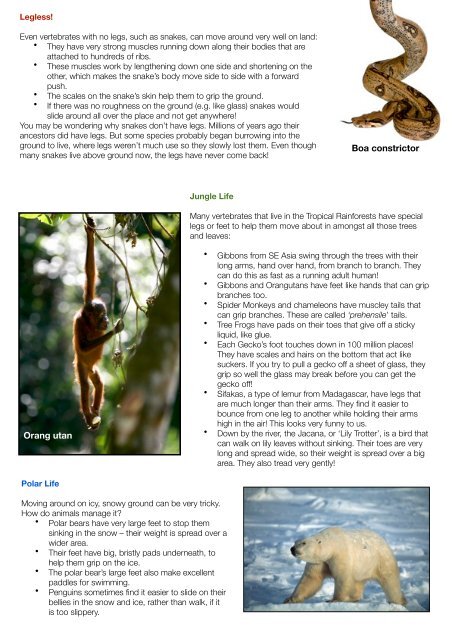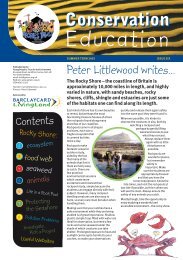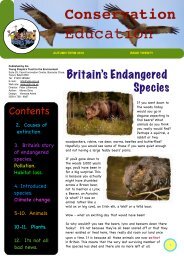How Animals Move - Young People's Trust for the Environment
How Animals Move - Young People's Trust for the Environment
How Animals Move - Young People's Trust for the Environment
- No tags were found...
You also want an ePaper? Increase the reach of your titles
YUMPU automatically turns print PDFs into web optimized ePapers that Google loves.
Legless!Even vertebrates with no legs, such as snakes, can move around very well on land:• They have very strong muscles running down along <strong>the</strong>ir bodies that areattached to hundreds of ribs.• These muscles work by leng<strong>the</strong>ning down one side and shortening on <strong>the</strong>o<strong>the</strong>r, which makes <strong>the</strong> snake’s body move side to side with a <strong>for</strong>wardpush.• The scales on <strong>the</strong> snake’s skin help <strong>the</strong>m to grip <strong>the</strong> ground.• If <strong>the</strong>re was no roughness on <strong>the</strong> ground (e.g. like glass) snakes wouldslide around all over <strong>the</strong> place and not get anywhere!You may be wondering why snakes don’t have legs. Millions of years ago <strong>the</strong>irancestors did have legs. But some species probably began burrowing into <strong>the</strong>ground to live, where legs weren’t much use so <strong>the</strong>y slowly lost <strong>the</strong>m. Even thoughmany snakes live above ground now, <strong>the</strong> legs have never come back!Boa constrictorJungle LifeMany vertebrates that live in <strong>the</strong> Tropical Rain<strong>for</strong>ests have speciallegs or feet to help <strong>the</strong>m move about in amongst all those treesand leaves:Orang utan• Gibbons from SE Asia swing through <strong>the</strong> trees with <strong>the</strong>irlong arms, hand over hand, from branch to branch. Theycan do this as fast as a running adult human!• Gibbons and Orangutans have feet like hands that can gripbranches too.• Spider Monkeys and chameleons have muscley tails thatcan grip branches. These are called ‘prehensile’ tails.• Tree Frogs have pads on <strong>the</strong>ir toes that give off a stickyliquid, like glue.• Each Gecko’s foot touches down in 100 million places!They have scales and hairs on <strong>the</strong> bottom that act likesuckers. If you try to pull a gecko off a sheet of glass, <strong>the</strong>ygrip so well <strong>the</strong> glass may break be<strong>for</strong>e you can get <strong>the</strong>gecko off!• Sifakas, a type of lemur from Madagascar, have legs thatare much longer than <strong>the</strong>ir arms. They find it easier tobounce from one leg to ano<strong>the</strong>r while holding <strong>the</strong>ir armshigh in <strong>the</strong> air! This looks very funny to us.• Down by <strong>the</strong> river, <strong>the</strong> Jacana, or ‘Lily Trotter’, is a bird thatcan walk on lily leaves without sinking. Their toes are verylong and spread wide, so <strong>the</strong>ir weight is spread over a bigarea. They also tread very gently!Polar LifeMoving around on icy, snowy ground can be very tricky.<strong>How</strong> do animals manage it?• Polar bears have very large feet to stop <strong>the</strong>msinking in <strong>the</strong> snow – <strong>the</strong>ir weight is spread over awider area.• Their feet have big, bristly pads underneath, tohelp <strong>the</strong>m grip on <strong>the</strong> ice.• The polar bear’s large feet also make excellentpaddles <strong>for</strong> swimming.• Penguins sometimes find it easier to slide on <strong>the</strong>irbellies in <strong>the</strong> snow and ice, ra<strong>the</strong>r than walk, if itis too slippery.






